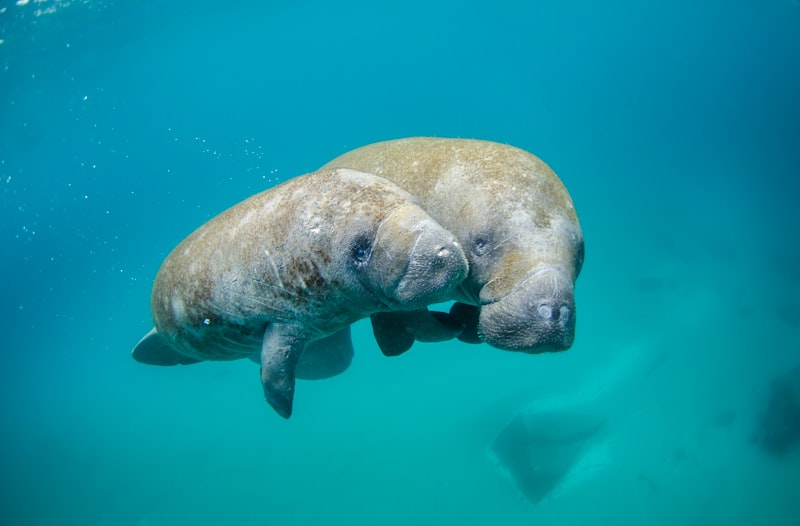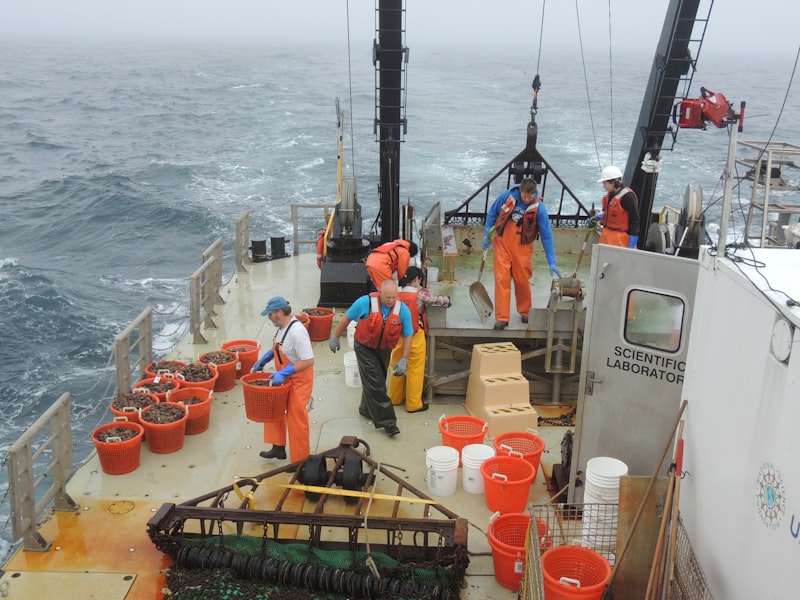Picture this: a vast underwater realm where the law of the jungle takes on a whole new meaning. In the depths of our oceans, the dynamics of marine predation are both intricate and awe-inspiring. From the smallest plankton to the largest apex predators, every creature plays a crucial role in this complex ecosystem.
At the heart of marine predation lies the perpetual struggle for survival. It’s a high-stakes game where speed, agility, and cunning determine who eats and who becomes the meal. Take the majestic orca, for example. With its sleek physique and razor-sharp intelligence, this apex predator reigns supreme in the oceanic food chain. Known as the “wolves of the sea,” orcas hunt in packs, strategizing their attacks on unsuspecting prey such as seals and even large whales.
But predation isn’t just about the big fish. It’s a finely tuned dance involving countless species. Consider the humble clownfish, navigating the perilous waters of coral reefs. In its symbiotic relationship with sea anemones, the clownfish finds protection while providing a steady supply of food for its host. This mutual dependency showcases nature’s remarkable ability to foster cooperation amidst the competition.
The ocean’s depths also harbor creatures with otherworldly adaptations. Take the deep-sea anglerfish, for instance. With its bioluminescent lure dangling in front of its mouth, this master of camouflage attracts unsuspecting prey into its deadly embrace. It’s a prime example of how evolution has sculpted organisms to perfection in the relentless pursuit of survival.
As we marvel at the intricacies of marine predation, we’re reminded of our responsibility to protect this fragile ecosystem. Human activities such as overfishing and pollution threaten to disrupt the delicate balance that sustains life beneath the waves. Each species, no matter how small or seemingly insignificant, plays a crucial role in maintaining the health of our oceans.
Next time you gaze out at the endless expanse of the sea, remember the unseen battles unfolding beneath the surface. The dynamics of marine predation are a testament to nature’s resilience and creativity. It’s a world where every creature must adapt or perish, where beauty and brutality coexist in perfect harmony.
Unveiling the Secrets: How Marine Predators Maintain Ecological Balance

Marine predators, from majestic sharks to agile dolphins and cunning orcas, play a crucial role in maintaining the delicate balance of our oceans. Beyond their fearsome reputation, these apex predators serve as nature’s guardians, ensuring the health and sustainability of marine ecosystems worldwide.
Imagine the ocean as a vast, interconnected web where every species has a role to play. Marine predators, positioned at the top of the food chain, exert influence that cascades down through every level below them. Their presence regulates populations of prey species, preventing any one group from overwhelming the ecosystem. This control helps maintain biodiversity by ensuring that no single species dominates, which is vital for the stability and resilience of ocean environments.
One of the most fascinating aspects of marine predators is their ability to shape behaviors and habitats of other marine life. For instance, the hunting patterns of sharks can influence the movement and feeding habits of fish lower down the food chain. This behavioral adaptation creates a natural rhythm that benefits not just predators and their prey, but the entire marine community.

Moreover, marine predators act as indicators of ocean health. Their presence and behavior provide valuable insights into the overall condition of marine ecosystems. Declines in predator populations often signal underlying issues such as overfishing or habitat degradation, prompting conservation efforts to restore balance and protect vulnerable species.
In essence, these creatures are not mere hunters of the deep; they are guardians of the seas. By maintaining ecological balance, marine predators ensure that our oceans remain vibrant and productive. Their conservation is not just a matter of preserving iconic species but safeguarding the very foundation of marine life itself.
From Prowess to Prey: Understanding the Strategic Moves in Marine Predation
Imagine the vast ocean as a battleground where survival hinges on strategic prowess. Marine predation, the act of one species hunting another for sustenance, unfolds in a complex dance of tactics and adaptations. From the lightning-fast strikes of the great white shark to the stealthy ambushes of the killer whale, each predator has honed its techniques through millennia of evolution.
Predators in the ocean employ diverse strategies tailored to their environments and prey. Take the orca, often dubbed the apex predator of the sea. With its intelligence and social structure, it orchestrates hunts with military precision, targeting anything from fish to seals. Unlike the solitary great white, orcas rely on teamwork, herding prey with calculated maneuvers before delivering a coordinated attack.
Then there’s the cunning octopus, a master of disguise and evasion. With its ability to change color and texture, it blends seamlessly into its surroundings, evading detection by would-be predators like the moray eel. This adaptive camouflage is not just a defense mechanism but a hunting strategy, allowing the octopus to stalk its prey unnoticed until the perfect moment to strike.
In contrast, the barracuda relies on sheer speed and agility. Known for its torpedo-like body and razor-sharp teeth, it darts through schools of fish with precision, capable of reaching speeds up to 27 miles per hour in short bursts. This predatory speed demon embodies the principle of swift and decisive action in the relentless pursuit of prey.
Understanding these strategic moves in marine predation offers a glimpse into the dynamic balance of life beneath the waves. Each predator, through its unique blend of instinct, adaptation, and skill, contributes to the intricate web of oceanic life, where every hunt is a testament to the relentless drive for survival and dominance.
Nature’s Underwater Battle: Exploring the Tactics of Marine Predators
In the depths of the ocean, a fierce and relentless battle unfolds every day—a battle that showcases the raw power and strategic brilliance of marine predators. From the stealthy sharks to the cunning octopus, these creatures have honed their tactics over millennia of evolution to become apex hunters in their watery realm.
Take the great white shark, for example. With its streamlined body and rows of razor-sharp teeth, this predator is the epitome of efficiency in hunting. Unlike many other fish, the great white possesses a unique ability to maintain its body temperature higher than that of the surrounding water, allowing it to patrol vast areas in search of prey without succumbing to the cold. When it strikes, it does so with explosive speed, often breaching the surface in a spectacular display of power.
On the other end of the spectrum lies the octopus, a master of disguise and strategy. With its ability to change color and texture in an instant, the octopus can blend seamlessly into its surroundings, becoming virtually invisible to unsuspecting prey. But camouflage is just one part of its arsenal. The octopus is also incredibly intelligent, capable of solving complex puzzles and opening jars to access hidden food sources. Its approach to hunting is akin to a skilled tactician, using patience and precision to outwit its opponents.
Meanwhile, the orca, or killer whale, represents a different kind of predator altogether. As highly social creatures, orcas often hunt in pods, coordinating their movements and communicating through a sophisticated system of clicks and calls. This teamwork allows them to take down much larger prey, such as seals or even whales, by employing synchronized attacks and strategic positioning.
Survival of the Fittest: Evolutionary Strategies in Marine Predation
When it comes to survival in the wild waters of our oceans, marine predators have evolved some of the most fascinating strategies. These creatures aren’t just skilled hunters; they are the epitome of evolutionary success in their environments. From the stealthy ambush tactics of the great white shark to the dazzling speed and agility of the sailfish, each species has honed its skills over millions of years of evolution.
Take the mighty orca, for instance. Known as the apex predator of the oceans, the orca employs a combination of intelligence, teamwork, and adaptability to hunt down even the most elusive prey. With their powerful communication skills and sophisticated hunting techniques, orcas can coordinate attacks on much larger animals like seals and even whales.
On the other end of the spectrum are the stealth hunters like the octopus. These masters of disguise use their ability to change color and texture to blend seamlessly into their surroundings, waiting patiently for the perfect moment to strike. Their complex nervous systems allow them to problem-solve on the fly, making them formidable opponents in the underwater world.
Then there are the lightning-fast predators such as the swordfish. With their streamlined bodies and sword-like bills, swordfish can accelerate to incredible speeds, piercing through schools of fish with precision. This evolutionary adaptation not only helps them catch prey but also evade larger predators like sharks.
In the vast and competitive realm of marine predation, survival hinges on adaptation and efficiency. Each species has carved out its niche through a combination of physical prowess, sensory acuity, and behavioral intelligence. From the smallest reef-dwelling fish to the largest oceanic hunters, every marine predator contributes to the delicate balance of the underwater ecosystem.
The Hunt Below: Investigating the Role of Stealth in Marine Predation
Stealth plays a pivotal role in the marine world, where survival depends on the ability to approach prey undetected. For predators like sharks, stealth is not just a skill but a finely tuned adaptation honed over millions of years of evolution. Imagine the ocean as a vast battlefield where every movement and sound can either spell success or failure in the hunt.
One of the key tactics predators use is camouflage. Just like a skilled sniper blends into their surroundings, marine predators such as the leopard seal or the tiger shark utilize patterns and colors that help them remain invisible to their prey. This natural camouflage allows them to get closer without triggering a defensive response.
But it’s not just about blending in visually. Marine predators also employ stealth through sound and movement. Some, like the orca or killer whale, are masters of silent hunting. They navigate through the water with minimal disturbance, relying on acute senses to pinpoint their prey before striking with deadly precision.
Consider the stealth of the great white shark, a creature so perfectly adapted to its environment that it can approach seals and other prey from below without causing a ripple. Its streamlined body and powerful muscles allow it to glide effortlessly, minimizing disturbance and maximizing surprise.
Stealth in marine predation isn’t solely about physical attributes; it’s also about strategy. Predators often use tactics that exploit the natural behavior of their prey. For example, some species of sharks use the cover of darkness to their advantage, hunting under the veil of night when visibility is limited and prey are less alert.
Frequently Asked Questions
What are examples of key marine predators and their impact on biodiversity?
Discover key marine predators like sharks, killer whales, and seals. Learn how they maintain biodiversity by regulating prey populations and influencing ecosystem balance.
What are the adaptations of marine predators for hunting underwater?
Learn about the unique adaptations of marine predators that enable them to hunt effectively underwater. Discover how these animals have evolved specialized features like streamlined bodies, keen senses, and powerful jaws to catch prey efficiently in their aquatic environment.
How do marine predators hunt and capture their prey?
This FAQ provides a concise overview of how marine predators hunt and capture their prey. It covers the techniques and strategies used by marine predators such as sharks, dolphins, and seals, including stealth, speed, and sharp senses. The description emphasizes the diversity of hunting methods employed in the ocean environment.
How do changes in marine predator populations affect marine ecosystems?
Learn how shifts in marine predator populations impact ocean ecosystems, influencing biodiversity, prey dynamics, and ecosystem stability.
What are marine predators and their role in ocean ecosystems?
Discover the role of marine predators in ocean ecosystems. Learn about their impact on biodiversity, food webs, and ecosystem stability.


